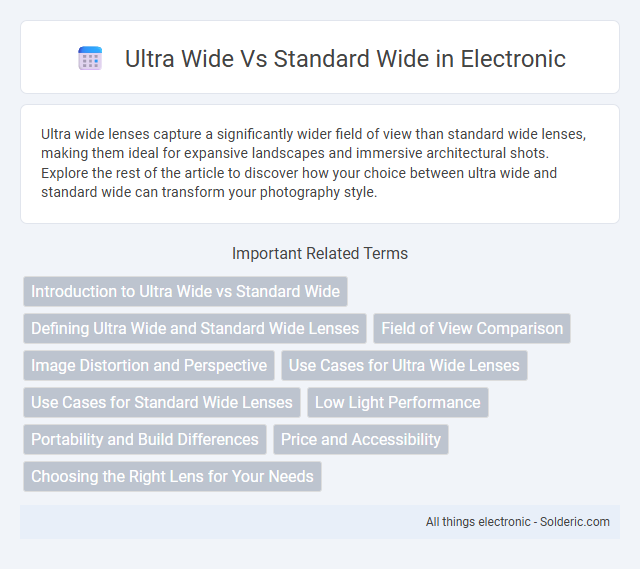Ultra wide lenses capture a significantly wider field of view than standard wide lenses, making them ideal for expansive landscapes and immersive architectural shots. Explore the rest of the article to discover how your choice between ultra wide and standard wide can transform your photography style.
Comparison Table
| Feature | Ultra Wide Lens | Standard Wide Lens |
|---|---|---|
| Field of View (FOV) | Typically 100deg to 120deg+ | Typically 60deg to 80deg |
| Focal Length | 8mm to 24mm (in 35mm equivalent) | 24mm to 35mm (in 35mm equivalent) |
| Distortion | Higher barrel distortion, especially at edges | Minimal distortion, more natural perspective |
| Use Cases | Landscapes, architecture, interiors, creative shots | General photography, portraits, street photography |
| Depth of Field | Greater depth of field, keeping more in focus | Shallower depth of field, easier background blur |
| Image Compression | May compress space, exaggerates size differences | More realistic spatial representation |
| Typical Aperture | f/2.8 to f/4 | f/1.8 to f/2.8 |
Introduction to Ultra Wide vs Standard Wide
Ultra wide lenses typically offer a focal length between 14mm to 24mm, providing a field of view around 104 to 120 degrees, while standard wide lenses range from 24mm to 35mm with a narrower angle of view from 65 to 84 degrees. Ultra wide lenses excel in capturing expansive landscapes and architectural interiors by emphasizing spatial depth, whereas standard wide lenses are ideal for general photography, offering natural perspectives with minimal distortion. Choosing between ultra wide and standard wide lenses depends on the desired composition, scene scale, and distortion tolerance in photography projects.
Defining Ultra Wide and Standard Wide Lenses
Ultra wide lenses typically have focal lengths between 14mm and 24mm, offering expansive fields of view that exceed 100 degrees, ideal for capturing vast landscapes and architectural interiors. Standard wide lenses usually range from 24mm to 35mm, providing a natural perspective without extreme distortion, making them suitable for street photography and environmental portraits. The key difference lies in the angle of view and image distortion, where ultra wide lenses emphasize spatial depth and dramatic perspectives compared to the more balanced framing of standard wide lenses.
Field of View Comparison
Ultra wide lenses capture a significantly broader field of view, typically ranging from 100 to 120 degrees, compared to standard wide lenses that offer around 70 to 85 degrees. This expansive perspective allows you to include more of the scene in a single frame, making ultra wide ideal for landscapes, architecture, and tight indoor spaces. Choosing between ultra wide and standard wide impacts how much of your environment is visible, affecting composition and storytelling in your photography or videography.
Image Distortion and Perspective
Ultra wide lenses cause more image distortion, especially near the edges, creating a dramatic, stretched effect that emphasizes depth and exaggerates perspective, while standard wide lenses maintain more natural proportions with minimal distortion. Perspective in ultra wide shots amplifies the sense of space, making objects closer to the lens appear significantly larger, which can be useful for creative composition but sometimes less flattering for portraits. Your choice between ultra wide and standard wide depends on whether you want exaggerated spatial dynamics or a more true-to-life representation.
Use Cases for Ultra Wide Lenses
Ultra wide lenses excel in landscape photography by capturing expansive scenes with dramatic perspective and depth. They are ideal for architectural photography, allowing photographers to include entire buildings or interiors without distortion. These lenses also benefit event photographers who need to capture large groups or dynamic environments in tight spaces.
Use Cases for Standard Wide Lenses
Standard wide lenses excel in versatility, making them ideal for everyday photography, including street scenes, environmental portraits, and landscapes. They offer a natural field of view that closely matches human vision, which ensures balanced composition and context without excessive distortion. Photographers often prefer standard wide lenses for travel and event photography due to their ability to capture broad scenes while maintaining subject clarity and depth.
Low Light Performance
Ultra wide lenses generally have smaller apertures compared to standard wide lenses, resulting in reduced low light performance. Standard wide lenses often feature larger apertures like f/1.8 or f/2.0, allowing more light to reach the sensor and produce clearer images in dim environments. This makes standard wide lenses more suitable for night photography or indoor shooting where lighting conditions are challenging.
Portability and Build Differences
Ultra wide monitors typically feature larger screens and wider aspect ratios, making them less portable and heavier compared to standard wide monitors, which are designed for easy mobility and compact setups. The build of ultra wide monitors often includes sturdier stands and larger bezels to support the extended display, whereas standard wide monitors prioritize lightweight materials and slimmer profiles for convenience. Your choice between the two should consider whether portability or immersive, expansive viewing space is more crucial for your needs.
Price and Accessibility
Ultra wide lenses typically cost more than standard wide lenses due to their complex optical design and specialized use, making them less accessible for casual photographers. Standard wide lenses offer a more affordable entry point while providing versatile focal lengths suitable for everyday shooting scenarios. Your choice depends on budget constraints and the specific photography needs you want to address.
Choosing the Right Lens for Your Needs
Choosing the right lens depends on the type of photography you pursue; ultra wide lenses offer expansive fields of view ideal for landscapes and architecture, capturing more of the scene in a single frame. Standard wide lenses provide a natural perspective closer to human vision, making them versatile for everyday photography, portraits, and events. Understanding your shooting environment and desired composition helps ensure your choice enhances your creative expression and image quality.
Ultra wide vs Standard wide Infographic

 solderic.com
solderic.com